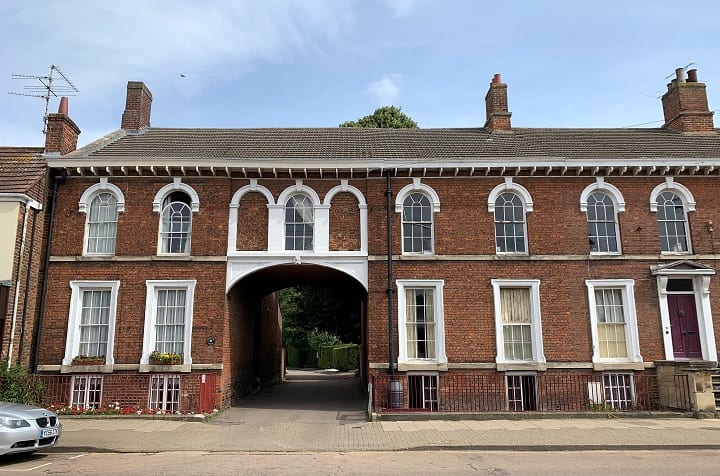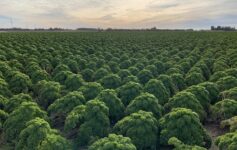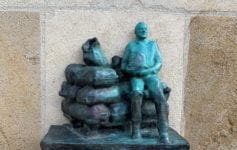
5th July 2012 was a special day for South Lincolnshire as the Olympic torch relay passed through the area on its way to London. To commemorate this event, local artist Fiona Gurney worked with over 900 volunteers to create five special mosaics. One was placed in Holbeach and takes pride of place in the centre of town. This mosaic, in Church Street, is the first stop on the new Holbeach Discovery Trail.

Created by members of the Holbeach Action Group to encourage the public to explore the town, this 1.5 mile route highlights points of interest of history, nature and art. Using digital technology, QR codes can be scanned on your mobile phone, revealing excellent information, old maps and photographs.
If you don’t have a smartphone you can still enjoy the trail. All of the information, plus a map of the trail, is available from the Holbeach Parish Council website. We decided to retain an element of surprise by hunting out the signs on the walk and flashing my phone at them. I downloaded a QR reader app on my phone and printed off a map of the route.
From the Olympic mosaic we walked through All Saints churchyard which looked very pretty with gorgeous orange blooms tumbling out of planters. We read a little of the history of the church and chuckled at the story from 1932 of Ned, Fred and the weather vane.
In the High Street, we learned about the history of The Chequers hotel which has been a feature in the town for centuries. There’s a wonderful account from the late 1700s describing what happened after a drinking session in the pub. The details can be found when you scan the code but here’s a little teaser: it involved card-players, the church and a corpse.
Number 4 on the route is The Mansion House, a stunning building in Queen Anne style which is now a hotel. It’s famous for being the birthplace of Sir Norman Angell who won the Nobel Peace Prize in 1933. What did he do to deserve such an honour? He was an executive on the World Committee against War and the League of Nations Union and campaigned against the aggressive policies of Germany, Italy and Japan during the 1930s. His book of 1910, ‘The Grand Illusion’, argued that integration of the European economies had grown to such a degree that war was pointless. His theory, ‘angellism’, stated that military and political power gave a nation no commercial advantage: one nation could not benefit by subjugating another.

We continued the trail along Albert Street and Victoria Street before reappearing on the High Street to spot a sign for the Grammar School Terrace. The buildings here were dormitories and the Headmaster’s accommodation for a school located behind the terrace. This school changed over the decades and is now the location for Small Saints Pre-School.

At St John’s Street we were directed to look across the road to the Co-op. On this spot was a cinema, The Hippodrome, opened in 1929. Dougie was particularly interested in the story of the doctor who lived next door who was chauffeured on his rounds in a very smart Ford V8 Pilot. He wished he could have done his own house calls this way.
Number 8 on the trail is the Nature Reserve. I used to bring my son, Rory, here in his pushchair when he was little, so he could feed the ducks. I’d forgotten what a lovely spot it is. Holding my mobile phone against the QR code on the fence, an old map and photo popped up. The reserve was originally old brick pits before being turned into a swimming club in 1895. Hard to imagine locals playing water polo and other aquatic sports here.
The trail continued to Damgate where we were encouraged to imagine one of seven mills that used to stand in Holbeach. In Edinburgh Walk the location of a former chapel is highlighted near the Police Station.
The cemetery, number 11 on the trail, was established in 1849. I recommend you pick up separate walking trails here to read fascinating stories of the lives and deaths of those buried here. You can also download these trails from the Holbeach Cemetery Chapels Trust.

We crossed the road and entered Carter’s Park, given to the town by Herbert Carter in 1929. The park has had a number of facilities over the years, including the bowls club, children’s playground and football pitch. Dougie flexed his muscles on the public gym equipment, one of the most recent additions. Spalding High School pupils have recently created a new mural in the park, an ongoing project adding colour to the football club fence.

Park Road is the next stop. I’ve walked past Park Hall hundreds of times and had no idea it was a former theatre, cinema and dance hall. I discovered it was also the location of a world record 12 hour piano-playing marathon in 1931.
The circuit of the Holbeach Discovery Trail began with the Olympic mosaic in the centre of town. It comes full circle at Market Hill, the location of another impressive mosaic. There are more historical revelations about Holbeach’s river which flowed underneath the crossroads.
The trail makes a brief detour west to finish in the grounds of the former Stukeley Hall, which is now a primary school. Dougie and I walked home from here, having spent an excellent morning in our town. I think the 1.5 mile trail is great for all ages. I’m sure kids will enjoy squabbling over who is going to flash the phone at the QR code. The route passes lots of places for refreshments so you can pick up a milkshake, ice cream or pop into a cafe or pub on the way round.
All the information about the Holbeach Discovery Trail can be found on the parish council website. There’s also a large map on Market Hill where the route begins. If you live in the area or just visiting, this is such a novel way to learn about Holbeach.






Really enjoyed this tour of Holbeach but so many other great landmarks…the sound of the Berrington Gate flour mill at night sticks in my childhood mind. The siren on the market Hill once used to call out the volunteer firemen and the march of residents from Fleet Road hospital to see a film at the Hipperdrome on a Saturday afternoon.